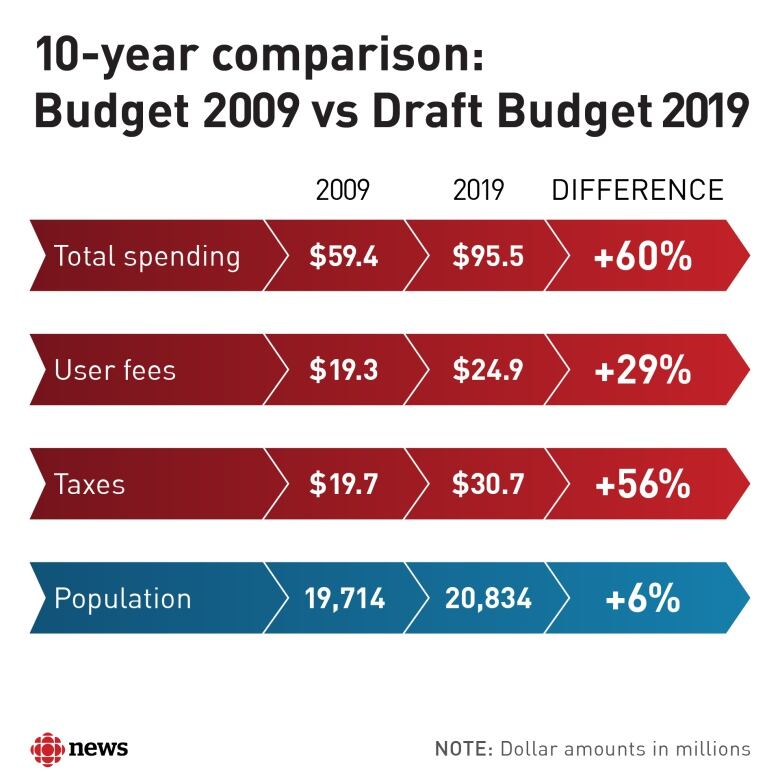Yellowknife's draft budget continues trend of major cost increases
Draft proposes 60% more total spending than 10 years ago, population has only increased 6%

Next week, when Yellowknife's newly-elected mayor and council begin reviewing the city budget for next year, they will begin with a plan that proposes spending 41 per centmore on operations and maintenance than was spent last year.
The city says those proposed increases are largely due to rising wage, electricity and fuel costs.
Those rising costs, as well as food costs, are affectingthe people the city is turning to to pay thempeople like 51-year-old resident and senior citizen Merlyn Williams.
It's not getting any easier, financially it's not, definitely not.- MerlynWilliams, retiree, former city councillor
"It's not getting any easier, financially it's not, definitely not," said Williams, who owns his own home. He and his wife live on a fixed income and must get by on Canada Pension Plan and income supplement benefits.
Williams says he's thought of leaving to live in a less expensive city.
"But we brought up two daughters in this town. They're both still here. And we've got five delightful grandchildren. So, no, we don't want to leave town. We're going to stay because we've got family here."
A former Yellowknife city councillor, Williams says he is thankful for the help he and his wife get through territorial government programs, with things such as home repairs and heating fuel costs.
And the 41 per cent increase may be understating the true rise in costs. The waythe city organizes its budget, that figure does not include a 14 per centincrease over 2017 in the single biggest cost the city incurs each year:wages and benefits.

City spending outpaces inflation
According to city documents, operational spending at Yellowknife city hall has climbed steadily each year, outpacing inflation by a wide margin. The city spent $14.2 million on operations and maintenance in 2009, not including wages and benefits. It is proposing to spend $22.9 million in 2019, an increase of 62 per cent.
During that same period, the city's population increased by only about six per cent.
When proposed capital spending is included, the draft budget envisions spending a total of $95.1 million next year, a 60 per centincrease over overall spending 10 years ago.
"We urge council to scrutinize the city's services to ensure they are well-used and appropriate for a city of 20,000 people," says the Yellowknife Chamber of Commerce in a letter to the city on the 2019 draft budget.
The chamber also encouraged the city to lobby for the $11.4 million the city says it's being shortchanged each year by the territorial government the city referenced the number again this year in the introduction to their draft budget.

In addition to rising fuel, wages and electricity costs, the city says its 2019 operating costs include some items previously counted as capital costs, such as wildfire mitigation, water licence renewal costs and the purchase of some equipment.
The 2019 draft budget proposes spending $150,000 on wildland fire mitigation next year. It's not clear from the budget how much is proposed for water licence renewal, what equipment acquisitions the city was referring to or how much they cost.
Without providing any specifics, the city also says the offering of additional programs and services has also driven up costs.
The biggest new facility that's added to the city's costs in the last 10 years is the fieldhouse, with indoor soccer fields and a running track. It opened in 2010. The city budgeted $626,000 to operate it in 2011, its first full year of operations. For 2019, the draft budget proposes spending $851,000 to operate it, an increase of 36 per cent.
Other spending planned for programs added in the last 10 years include $371,000 on the Street Outreach program to transport intoxicated or homeless people tosafe places, $50,000 for the homeless day shelter, and $103,000 for a homelessness employment program.

Hidden costs
While the city has had relatively modest property tax increases over the last 10 years, (the draft budget proposes a 1.44 per centincrease for 2019) taxpayers have been footing the bill for rising spending at city hall through steadily increasing "user fees" for everything from drinking water to recreation.
Next year the city plans to collect $24.9 million in user fees, 29 per centmore than it collected 10 years ago.
In addition to discretionary programs such as recreation, user fees include garbage collection and water and sewer services. Water and sewer fees are projected to increase by four per cent in the coming year and another three per cent in 2020.
Along with increasing operating costs, the city is proposing to ramp up capital costs to record levels in the coming years. An official earlier warned that building an aquatic centre and replacing an underwater pipe to draw drinking water from the Yellowknife River could push the city close to its legislated debt limit.
The cost of carrying that debtnever mind paying it offis going to leave the city with even less money in the future. According to the draft budget, interest payments alone on long-term debt are projected to rise from $565,000 this year to more than $2 million in 2021.
Newly-elected Mayor Rebecca Alty and council start reviewing the draft budget on Nov. 27.












_(720p).jpg)


 OFFICIAL HD MUSIC VIDEO.jpg)
.jpg)



























































































